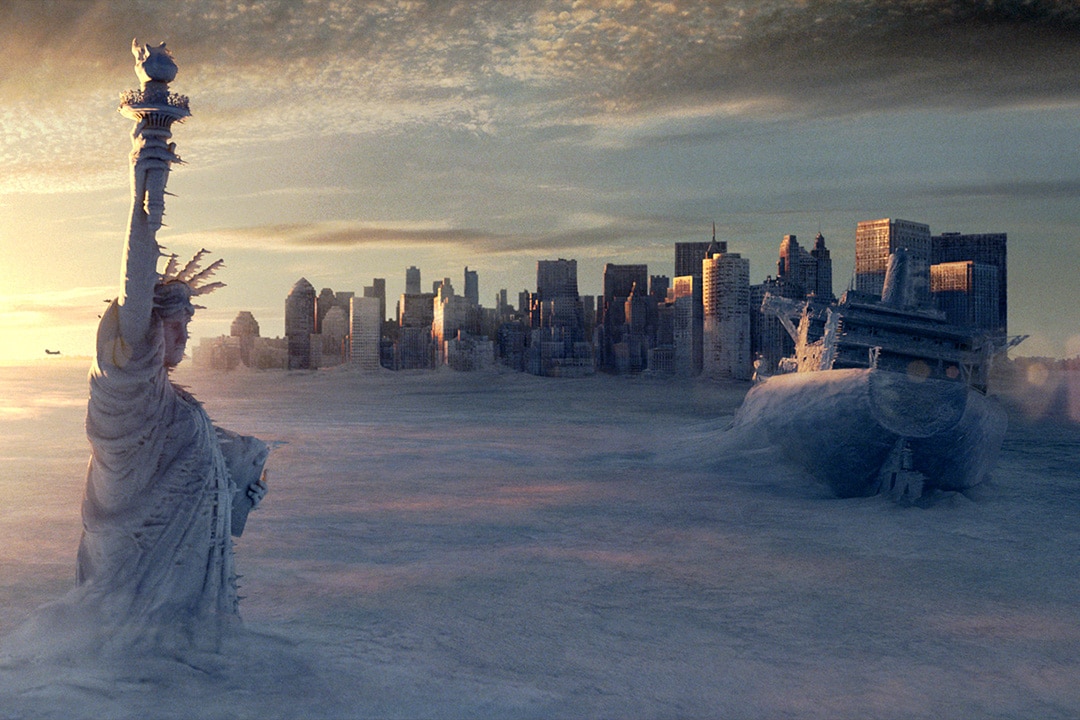Create a free profile to get unlimited access to exclusive videos, sweepstakes, and more!
Most frigid place on Earth is way colder than average temperature on Mars
You'll find warmer locales on Mars.

In 2004, the king of disaster cinema, Roland Emmerich, brought us yet another vision of the end of the world in The Day After Tomorrow (now streaming on Peacock!). It largely follows a group of high school students including Sam Hall (Jake Gyllenhaal), the son of Jack Hall (Dennis Quaid), a paleoclimatologist working for the National Oceanic and Atmospheric Administration.
During an expedition gathering ice cores in Antarctica, Jack witnesses a large piece of the ice shelf break away, spurring him to warn the United Nations of a looming ice age. His warnings, unfortunately, are disregarded. Shortly thereafter, they’re proven right when the storm to end all storms — actually three storms all working together — descends upon the planet.
These aren’t just your ordinary killer storms, throwing wind and water with abandon, the secret to their success is the incredibly low temperatures they’re carrying. Anything caught in their centers is frozen instantly, as it’s exposed to temperatures as low as 150 degrees Fahrenheit below zero. By the time the storms subside, Jack believes the world will have entered a new ice age.
While the speed, ferocity, and intense temperatures of the storms in The Day After Tomorrow strain credulity, they did foreshadow an extreme earthly environment still waiting to be discovered. In 2013, almost a decade after the film’s release, NASA scientists identified the coldest spot on the planet, a spot which rivals the eye of Emmerich’s fictional storm.
RELATED: 'The Day After Tomorrow' crew looks back on Roland Emmerich's 'prescient' climate thriller.
The hunt for the world’s coldest spot began when scientists were studying snow dunes on the East Antarctic Plateau. They noticed cracks in the snow between dunes and hypothesized that as temperatures grew colder, the snow shrank, and cracks appeared. In order for that to happen temperatures would need to be staggeringly low, and scientists set out to find out just how cold they were.
First, they used NASA’s Moderate Resolution Imaging Spectroradiometer aboard the Terra and Aqua satellites, as well as the Advanced Very High Resolution Radiometer on various NOAA satellites. Those instruments provided low-resolution data of the East Antarctic Plateau and identified a 620-mile region along a high ridge between the Argus and Fuji domes with incredibly low temperatures. Those first scans also provided a hint that even colder temperatures might exist in pockets within the ridge.
Researchers then turned to the Thermal Infrared Sensor aboard the Landsat 8 satellite, launched in February 2013, which provided higher resolution and pinpointed the precise location of the world’s coldest spot. More accurately, we should say the world’s coldest spots. The data revealed that temperatures dip to frigid temperatures inside hollows along the Antarctic ridge.
According to a recent Facebook post from NASA’s Goddard Space Flight Center, these pockets can drop to negative 135 degrees Fahrenheit under the right conditions. Looking through 32 years’ worth of data, scientists detected dozens of instances during which the temperatures plunged into record breaking territory. The coldest detected temperature, to date, occurred on Aug. 10, 2010, when the thermostat in one of these Antarctic pockets dipped to 136 degrees below zero.
Temperatures that low stretch our powers of imagination. That’s 93 degrees below zero on the Celsius scale, and significantly colder than the average temperature on Mars, which is roughly 80 below zero on the Fahrenheit scale. These Antarctic death traps do have air to breathe, they beat Mars in that respect, but that’s about it. You’d be a corpsicle in a few minutes either way.
A frostbite time chart from the National Weather Service only looks at temperatures as low as 45 Fahrenheit below zero, with 60 mile per hour winds for a perceived temperature of 98 below. That’s considerably warmer than we expect in the Antarctic hollows, and they estimate frostbite would occur in less than five minutes. We weren’t able to locate any clear numbers on how long you could last at the world’s coldest spot, but we’re willing to bet it’s not very long.
The temperature inside these Antarctic pockets gets so low thanks to a strange combination of location and geology. Antarctic temperatures are already cold, which helps to get the heat leeching process started. When skies clear, temperatures on the ground get even colder as heat radiates away into space. If the skies stay clear long enough, temperatures get so cold that a layer of super chilled air collects at the surface. That air is not only colder than surrounding air, but also denser. As a result, it slides into hollows and pockets, low spots in the landscape relatively shielded from sunlight or wind. That air can remain in place, undisturbed for long periods of time, while it continues to bleed heat into space.
That’s the recipe for the coldest temperatures on Earth, temperatures so cold that in 2004 they could exist only in our imaginations. Here’s hoping they stay in the Antarctic where they belong.
Looking for a real-life story of humanity at odds with the Earth’s extreme environments? Everest tells the story of the deadliest disasters in climbing history, now streaming on Peacock.



























